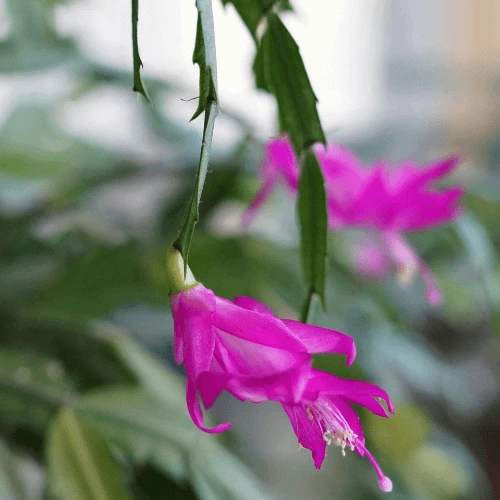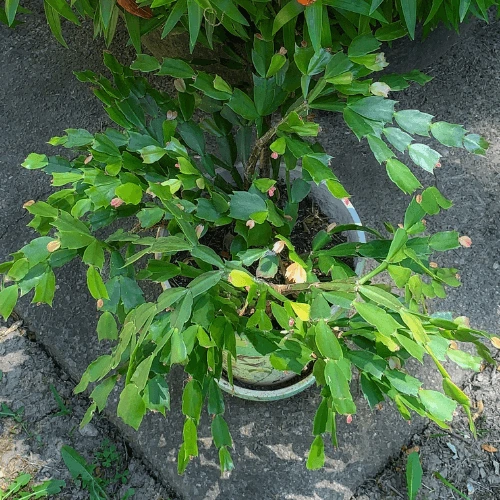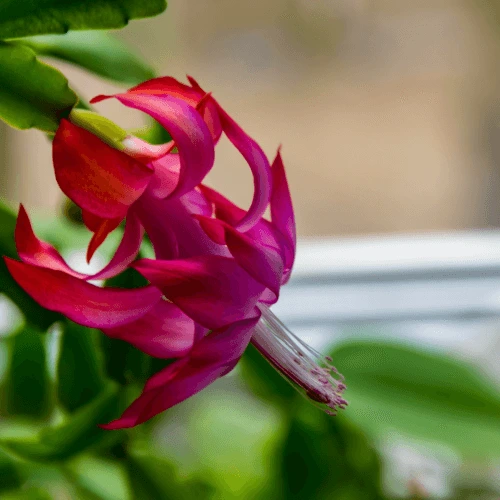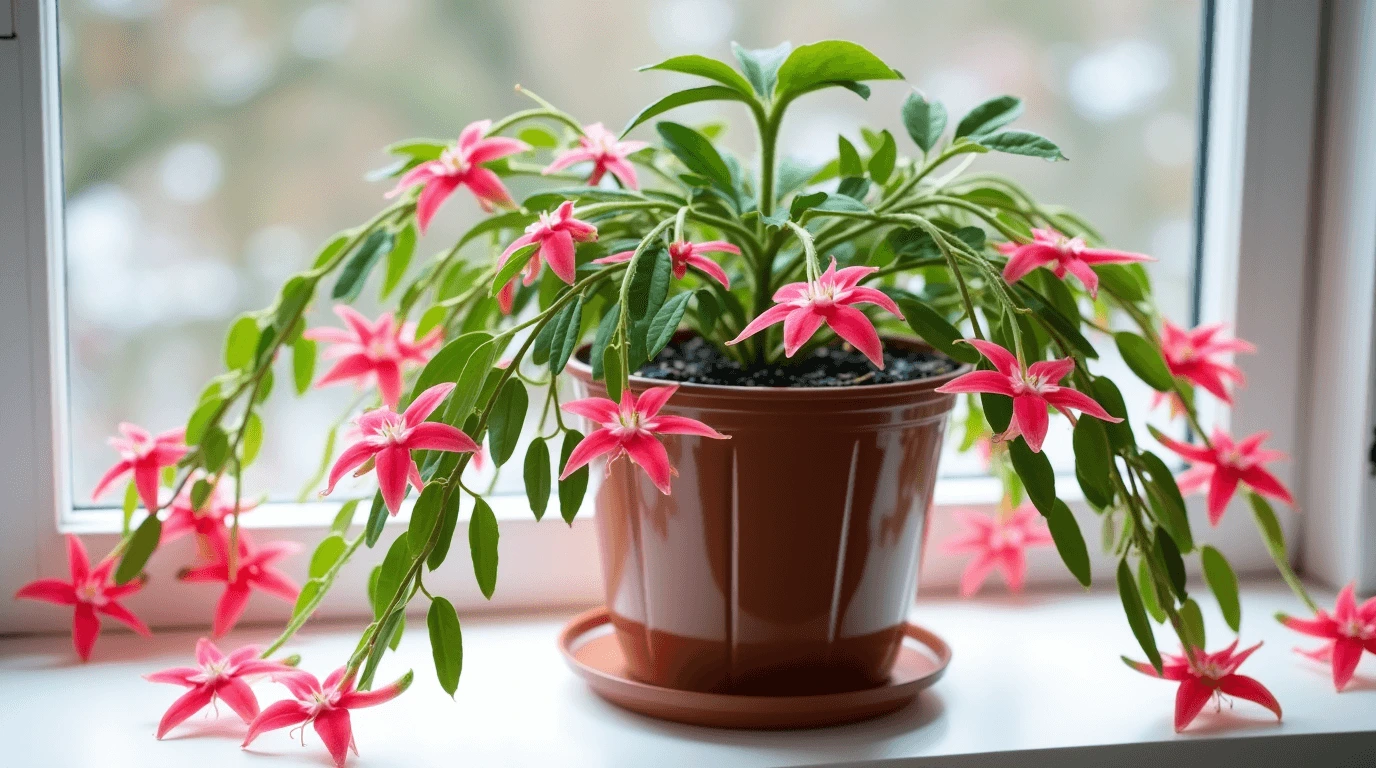Have you ever wondered how to keep your Christmas cactus looking lush and vibrant year after year? Known for its colorful holiday blooms and easygoing nature, this tropical plant is a favorite for adding festive charm to any home. But, while it’s not demanding, Christmas cactus care does require a little know-how to bring out its full potential.
Are you struggling with when to water it or why it’s not blooming? Or perhaps you’re curious about the best spot to place it? Don’t worry—you’re not alone. Whether you’re a plant enthusiast or just starting your green-thumb journey, this guide has everything you need to help your Christmas cactus thrive.
From planting and watering to seasonal tips and troubleshooting, we’ll walk you through every step to make your cactus the star of your holiday decor. Ready to unlock the secrets to stunning blooms? Let’s dive in! 🌿
In This Article
Understanding the Christmas Cactus
The Christmas cactus isn’t your typical desert cactus—it’s a tropical gem that thrives in unique conditions. Native to the coastal rainforests of Brazil, this plant grows as an epiphyte, clinging to trees and absorbing moisture from the humid air. Its lush, segmented leaves and vibrant blooms make it a beloved choice for homes, especially during the holiday season.
Did you know that not all holiday cacti are “Christmas cacti”? Three distinct types can be identified, each with its own unique features:
- Thanksgiving Cactus (Schlumbergera truncata): Blooms in late November with jagged, claw-like leaves.
- Christmas Cactus (Schlumbergera russelliana): True to its name, it blooms around Christmas with smooth, scalloped leaf edges.
- Easter Cactus (Rhipsalidopsis gaetneri): A spring bloomer with rounded leaves and waxy flowers.
To identify your cactus, look closely at the leaf shape and blooming time. If your plant flowers in November and has pointed leaves, it’s likely a Thanksgiving cactus. Smooth-edged leaves and December blooms indicate a Christmas cactus.
What sets the Christmas cactus apart is its ability to thrive with proper care. By understanding its origins and unique needs, you’ll set the stage for a healthy, thriving plant that brings joy for years to come. Ready to dive deeper into its care and ensure those stunning blooms? Let’s get started! 🌿



| Common Name | Christmas Cactus |
| Botanical Name | Schlumbergera russelliana |
| Family | Cactaceae |
| Plant Type | Perennial, Epiphyte |
| Mature Size | 6-12 inches tall, 12-24 inches wide |
| Bloom Time | Winter (November – January) |
| Toxicity | Non-toxic to humans and pets |
| Sun Exposure | Bright, Indirect Light |
| Soil Type | Well-draining, Cactus/Succulent Mix |
| Soil pH | Slightly Acidic (pH 5.5 – 6.5) |
| Flower Color | Red, Pink, White, Purple, Yellow |
| Hardiness Zones | USDA Zones 10-12 (Indoors Everywhere) |
| Native Area | Brazil (Tropical Rainforests) |
How to Plant a Christmas Cactus
Planting a Christmas cactus is easier than you think, and setting it up right from the start ensures years of thriving growth and vibrant blooms. Whether you’re repotting an older plant or starting fresh with a cutting, here’s how to give your cactus the best foundation.
Choosing the Right Pot and Soil
A healthy Christmas cactus begins with the right pot and soil.
- Pot Selection: Always choose a pot with drainage holes to prevent water pooling at the bottom, which can lead to root rot. Terracotta or ceramic pots are ideal because they allow the soil to breathe while maintaining moisture balance.
- Soil Composition: Unlike desert cacti, Christmas cacti prefer a moist but well-draining soil mix. Use a cactus potting mix, or make your own by combining potting soil with sand or perlite for added drainage.
Step-by-Step Planting Instructions
Ready to repot or plant your Christmas cactus? Follow these simple steps:
- Choose the Right Time: The best time to repot is spring, after the plant has finished blooming. Avoid repotting during the bloom phase to reduce stress.
- Prepare Your Pot and Soil: Fill your pot halfway with the cactus-friendly soil mix. Ensure it’s light, airy, and well-draining.
- Gently Remove the Plant: If repotting, carefully take the cactus out of its current pot. Loosen the roots gently, but avoid damaging them.
- Position the Plant: Place the cactus in the center of the new pot. Add soil around the roots, pressing lightly to secure the plant without burying the leaves.
- Water Sparingly: After planting, water lightly to help the soil settle. Avoid soaking the plant—Christmas cacti dislike soggy roots.
By following these steps, you’ll create the ideal environment for your Christmas cactus to flourish. Whether you’re giving a cutting its first home or refreshing the soil for an older plant, proper planting makes all the difference. Up next, we’ll explore essential care tips to keep your cactus thriving all year round. 🌿
Essential Care Tips for Christmas Cactus
Caring for a Christmas cactus requires finding the perfect balance of light, water, and temperature. With the right routine, this tropical beauty becomes one of the easiest and most rewarding houseplants to maintain.
Light Requirements
Wondering how much light your Christmas cactus needs? Bright, indirect sunlight is key to keeping it healthy.
- Best Placement: Position it near an east- or north-facing window where it receives filtered light throughout the day.
- Avoid Direct Sunlight: Too much direct sun can scorch the leaves, while too little light may stunt growth or delay blooming.
- Signs of Issues: Red or purple-tinted leaves indicate too much sun, while pale, weak leaves suggest insufficient light.
Watering Tips
Unlike desert cacti, Christmas cacti thrive with regular watering—but balance is crucial.
- How Often to Water: Water when the top 1-2 inches of soil feel dry. During active growth (spring and summer), this may be weekly. Reduce watering to once every 2-3 weeks in cooler months.
- How to Water: Water thoroughly until it drains from the bottom of the pot. To avoid root rot, make sure to empty the saucer regularly.
- Overwatering Warning: Yellow, mushy leaves are a sign of overwatering. Conversely, wrinkled or dry leaves indicate underwatering.
Temperature and Humidity Needs
As a tropical plant, the Christmas cactus loves consistent warmth and humidity.
- Optimal Temperatures: Daytime temperatures of 65-75°F and nighttime temperatures of 50-55°F encourage growth and blooms.
- Humidity Tips: Increase humidity with a pebble tray, humidifier, or occasional misting, especially during dry winter months.
By mastering these care essentials, you’ll set your Christmas cactus up for a lifetime of health and beauty. Keep reading to learn about pruning and propagation to maintain its shape and multiply your collection! 🌿
Pruning and Propagating Christmas Cactus
To keep your Christmas cactus healthy, lush, and blooming, pruning and propagating are key. Pruning promotes fuller growth and prepares your plant for the next blooming season, while propagation lets you create new plants to share or expand your collection. Here’s how to do both with ease.
When and How to Prune
Pruning may sound intimidating, but it’s simple and beneficial.
- Why Prune? Pruning encourages new branches, keeps your cactus compact and bushy, and prepares it for more blooms.
- When to Prune: Prune after the blooming season ends, usually in late winter or early spring. Avoid pruning during the bloom phase, as this can cause flowers to drop.
- How to Prune:
- Identify leggy or uneven segments that need trimming.
- Use clean, sharp pruning shears or scissors to cut at the natural joint between segments.
- Remove no more than 25-30% of the plant at a time to avoid stress.
Propagation Methods
Propagation is an easy and satisfying way to grow new Christmas cacti from cuttings.
- Using Stem Cuttings:
- Take cuttings with 2-5 segments from a healthy plant.
- Let the cut ends dry and form a callous for 24-48 hours to protect against rot.
- Plant the cuttings in well-draining soil, burying the base about 1 inch deep.
- Rooting in Water:
- Place the cuttings in a glass of water, submerging only the base.
- Change the water every few days to keep its freshness.
- Once roots are 1-2 inches long, transfer the cutting to soil.
With proper pruning and propagation, your Christmas cactus will flourish, and you’ll enjoy a thriving plant collection year-round. Keep reading for tips on growing your cactus from seeds! 🌿
Pruning and Propagation: Your Cactus Care Cheat Sheet
Here’s a quick summary of the most important pruning and propagation tips:
✅ Prune after blooms fade to avoid stress on the plant.
✅ Remove no more than 25-30% of the plant at a time.
✅ Use cuttings to propagate in soil or water.
✅ Let cut ends callous for 24-48 hours before planting in soil.
✅ Water the cuttings lightly to keep soil slightly moist, but not wet.
Growing Christmas Cactus from Seeds
If you’re looking for a rewarding project, growing a Christmas cactus from seeds is a fantastic way to nurture a plant from the very beginning. While it takes patience, the process is simple and can yield unique plants with their own distinct traits.
Why Grow from Seeds?
- Unique Characteristics: Seed-grown cacti may develop variations in flower color or leaf shape.
- Satisfying Journey: Watching a cactus grow from a tiny seed to a blooming plant is deeply fulfilling.
- Hardier Plants: Seed-grown Christmas cacti adapt to your home’s environment, making them resilient over time.
Step-by-Step Seed Growing Process
- Collect or Purchase Seeds:
- To collect seeds, pollinate flowers using a cotton swab, then wait for the fruit to ripen (6-12 months).
- Alternatively, buy seeds from a reputable nursery for faster access.
- Prepare the Soil:
- Use a shallow container with a well-draining mix of potting soil, sand, and perlite. Lightly moisten the soil.
- Plant the Seeds:
- Spread the seeds over the surface and gently press them in. Don’t bury them—seeds need light to germinate.
- Create a Mini-Greenhouse:
- Use clear plastic wrap or a lid to cover the container and retain humidity.
- Provide Warmth and Light:
- Place the container in a spot with bright, indirect light and keep temperatures between 70-80°F.
- Wait for Germination:
- Germination can take 3-8 weeks. Once sprouts appear, remove the cover and care for them like seedlings.
Growing from seeds may take time, but it’s worth the effort. Stay patient, and you’ll be rewarded with new plants to nurture and share! 🌿
Seasonal Care and Overwintering Tips
A thriving Christmas cactus requires seasonal adjustments to its care routine. By aligning with the plant’s natural growth and blooming cycles, you’ll keep it healthy year-round.
Seasonal Care Routine
- Spring: After blooming, focus on growth by repotting if needed and fertilizing every 4-6 weeks. Keep the plant in bright, indirect light and water the plant once the top 1-2 inches of soil have dried out.
- Summer: Increase humidity with a pebble tray or humidifier. Water more frequently and, if weather permits, place the cactus outdoors in a shaded area.
- Fall: Trigger blooming by giving the plant 12-14 hours of darkness each night for 6-8 weeks. Reduce watering to once every 3-4 weeks and avoid fertilizing. Maintain nighttime temperatures of 50-55°F.
- Winter: During blooming, keep the environment stable and avoid moving the plant. Water sparingly and boost humidity to prolong blooms.
Overwintering Tips
Overwintering helps prepare your cactus for its holiday bloom. Reduce watering, lower nighttime temperatures, and ensure it gets its required darkness. Once buds form, avoid moving the plant to prevent bud drop.
By adapting your care to each season, you’ll create the ideal environment for vibrant blooms and a healthy cactus all year round. 🌿
Quick Care Tips for Each Season
| Season | Watering | Light | Fertilizer | Temperature |
| Spring | Moderate, every 7-10 days | Indirect sunlight | Feed every 4-6 weeks | 65-75°F (18-24°C) |
| Summer | Water weekly | Indirect light (can go outside) | Fertilize monthly | 70-80°F (21-27°C) |
| Fall | Reduce to 3-4 weeks | 12-14 hours of darkness | Stop fertilizing | 50-55°F (night) |
| Winter | Water every 2-3 weeks | Bright, indirect light | No fertilizer | 65-70°F (day) |
Common Pests and Diseases of Christmas Cactus
Even with proper care, your Christmas cactus can face occasional pests and diseases. Identifying and addressing these issues early ensures your plant stays healthy and thriving.
Common Pests
- Mealybugs: Check for white, cottony clusters on the leaves and stems. Remove them using a cotton swab dipped in rubbing alcohol, and repeat every few days.
- Spider Mites: Tiny red or brown specks with delicate webbing indicate spider mites. Increase humidity, rinse the plant, and apply neem oil or insecticidal soap.
- Fungus Gnats: If tiny black flies hover near the soil, allow the top layer to dry out and use sticky traps to control adults.
- Scale Insects: Brown, oval bumps on stems are a sign of scale. Remove manually with alcohol or use horticultural oil.
Fungal Diseases
- Root Rot: Caused by overwatering, root rot makes leaves yellow and mushy. Repot the plant in fresh, well-draining soil and trim away rotted roots.
- Leaf Spot Disease: Brown or black spots on leaves signal fungal infection. Eliminate the affected leaves and treat with a fungicide.
- Botrytis Blight: Gray mold on leaves or flowers appears in cool, damp conditions. Increase airflow and remove infected parts.
Prevention Tips
- Choose well-draining soil and pots with drainage holes to avoid overwatering.
- Examine new plants for pests before adding them to your collection.
- Maintain proper humidity and airflow to avoid fungal issues.
Summary of Pests and Diseases of Christmas Cactus
| Problem | Symptoms | Cause | How to Fix |
| Mealybugs | White, cotton-like residue | Infestation | Remove with alcohol-soaked cotton swab |
| Spider Mites | Webbing, discolored leaves | Low humidity | Increase humidity, rinse leaves |
| Root Rot | Yellow, mushy roots | Overwatering | Repot, trim damaged roots |
| Leaf Spot | Brown, black spots | Fungal infection | Remove leaves, apply fungicide |
| Scale Insects | Brown bumps on stems | Infestation | Remove with alcohol, use oil spray |
By staying vigilant and proactive, you can keep your Christmas cactus pest- and disease-free, ensuring a vibrant and healthy plant year-round. 🌿
Blooming Tips for a Stunning Christmas Display
The holiday season isn’t complete without the vibrant blooms of a Christmas cactus. But ensuring your plant flowers in time requires a little planning and care. Here’s how to trigger and prolong those stunning blooms.
How to Trigger Blooming
To encourage blooming, mimic the natural conditions that signal the plant to flower:
- Darkness Routine: Start in the fall by giving your cactus 12-14 hours of total darkness each night for 6-8 weeks. Place it in a dark room or cover it with a breathable cloth.
- Cooler Nights: Lower nighttime temperatures to 50-55°F, while maintaining daytime temperatures of 60-70°F.
- Reduce Watering: During the pre-bloom phase, water sparingly, only when the top 1-2 inches of soil feel dry.
- Stop Fertilizing: Avoid feeding the plant in the months leading up to blooming.
Maximizing Bloom Duration
Once buds form, keep the environment stable to prevent them from dropping.
- Avoid Moving: Don’t move or rotate the plant, as this can cause stress and bud loss.
- Maintain Humidity: Use a pebble tray or humidifier to keep the air moist, especially during dry winters.
- Water Wisely: Keep the soil slightly moist but never soggy.
With a little attention, your Christmas cactus will reward you with breathtaking blooms that light up your holiday decor. Ready to keep those flowers coming year after year? Keep reading for answers to common cactus care questions! 🌿
FAQs
Where Should I Place My Christmas Cactus?
The best spot is near an east- or north-facing window with bright, indirect light. Avoid direct sunlight, which can scorch the leaves, and keep it away from drafts or heat sources.
How Often Should I Water It?
Water when the top 1-2 inches of soil are dry. In summer, this may mean weekly watering. In winter, reduce to once every 2-3 weeks. Always drain the saucer to prevent root rot.
Why Isn’t My Cactus Blooming?
To trigger blooms, provide 12-14 hours of darkness nightly for 6-8 weeks, cooler nighttime temperatures (50-55°F), and reduce watering during the pre-bloom phase.
What’s the Lifespan of a Christmas Cactus?
With proper care, a Christmas cactus can live for decades, often passed down as a family heirloom.
Recommended Tools and Accessories for Christmas Cactus Care
Having the right tools makes caring for your Christmas cactus a breeze. Here are the essentials to help your plant thrive:
- Pruning Shears: Use sharp, clean shears to prune leggy growth and maintain a bushy shape.
- Watering Can: Choose one with a narrow spout for controlled watering, preventing overwatering and root rot.
- Soil Moisture Meter: Avoid guesswork by using a meter to check if the soil is dry before watering.
- Humidity Tray: Boost humidity by placing the pot on a pebble-filled tray with water, especially during dry winters.
- Terracotta Pot: Opt for pots with drainage holes to maintain proper moisture levels and prevent soggy roots.
- Neem Oil Spray: Keep pests like mealybugs and spider mites at bay naturally.
These tools not only simplify plant care but also help your Christmas cactus flourish year-round. Ready to see your cactus bloom like never before? With these essentials, success is just a step away! 🌿
Conclusion
Mastering Christmas cactus care isn’t just about keeping a plant alive—it’s about creating a vibrant, living centerpiece that fills your home with beauty and joy, especially during the holiday season. With the right balance of light, water, and temperature, your Christmas cactus can become a long-lasting addition to your collection of indoor plants, thriving year after year.
So, what’s next? Are you ready to implement these care tips and see your cactus bloom brighter than ever? From perfecting your watering schedule to creating the ideal environment for flowering, every small effort you make will bring big rewards.
And don’t stop there! Whether you’re propagating new plants to share with friends or exploring care routines for other indoor plants, your journey as a plant enthusiast has endless possibilities.
If you enjoyed this guide, why not share it with a fellow plant lover? And don’t forget to subscribe to our newsletter for more expert advice, plant care tips, and inspiration for creating your ultimate indoor garden. Let’s grow together! 🌿✨

